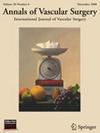戒烟辅助治疗在选择性血运重建术之前具有成本效益。
IF 1.6
4区 医学
Q3 PERIPHERAL VASCULAR DISEASE
引用次数: 0
摘要
前言:术前戒烟可减少术后不良后果。因此,在许多学科的选择性干预之前,对戒烟疗法的投资已被证明具有成本效益。尽管外周动脉疾病(PAD)患者的吸烟率很高,但择期血管重建术前戒烟的成本效益尚不清楚。方法:使用马尔可夫模型,我们评估了术前戒烟治疗(标准护理、咨询、尼古丁替代疗法[NRT]、伐尼克兰、安非他酮)对65岁有症状的PAD患者进行开放或血管内重建术的成本效益。当地数据量化了戒烟治疗费用。已有文献报道了治疗效果、术后结果(中风、心肌梗死、主要截肢、通畅、死亡)频率和术后费用。终身成本以美元量化,有效性以质量调整生命年(QALYs)量化,支付意愿阈值为100,000美元/QALY。敏感性分析检验了模型的稳健性。结果:在基本情况下,标准护理最便宜(326,280美元),伐尼克兰最昂贵(333,335美元)。然而,伐尼克兰是最有效的(7.11 QALYs),而标准治疗是最无效的(6.43 QALYs)。NRT和伐尼克兰是最具成本效益的治疗方法。在概率模拟(在1000次迭代中随机改变模型参数)中,varenicline在100,000美元/QALY获得时获得80.3%的青睐。假设吸烟状态没有死亡率差异,在单向敏感性分析中,伐尼克兰在所有其他治疗中占主导地位。结论:戒烟辅助治疗在PAD干预之前具有成本效益。伐尼克兰和NRT是最具成本效益的戒烟策略。我们的研究结果强调了在接受血管重建术的PAD患者中补充戒烟治疗的价值。本文章由计算机程序翻译,如有差异,请以英文原文为准。
Smoking Cessation Adjuncts Are Cost Effective Prior to Elective Revascularization
Background
Preoperative smoking cessation can reduce adverse postoperative outcomes. Investment in smoking cessation therapies has therefore proven cost effective prior to elective interventions across numerous disciplines. Despite high rates of smoking among patients with peripheral artery disease (PAD), the cost effectiveness of smoking cessation before elective revascularization is unclear.
Methods
Using a Markov model, we evaluated the cost effectiveness of preoperative smoking cessation therapies (standard care, counseling, nicotine replacement therapy [NRT], varenicline, bupropion) for 65-year-old patients undergoing open or endovascular revascularization for symptomatic PAD. Local data quantified smoking cessation therapy costs. Established literature informed therapy effectiveness, postoperative outcomes (stroke, myocardial infarction, major amputation, patency, death) frequencies, and postoperative costs. Lifetime costs were quantified in US dollars and effectiveness in quality-adjusted life-years (QALYs), with a willingness-to-pay threshold of $100,000/QALY gained. Sensitivity analyses tested model robustness.
Results
In the base-case scenario, standard care was least expensive ($326,280) and varenicline was costliest ($333,335). However, varenicline was the most effective (7.11 QALYs), while standard care was least effective (6.43 QALYs). NRT and varenicline were the most cost-effective therapies. In the probabilistic simulation (randomly varying model parameters over 1,000 iterations), varenicline was favored in 80.3% at $100,000/QALY gained. Assuming no mortality differences by smoking status, in one-way sensitivity analyses varenicline dominated all other therapies.
Conclusion
Smoking cessation adjuncts are cost effective prior to PAD interventions. Varenicline and NRT were the most cost-effective smoking cessation strategies. Our results highlight the value of supplemented coverage for smoking cessation therapies among patients with PAD undergoing revascularization.
求助全文
通过发布文献求助,成功后即可免费获取论文全文。
去求助
来源期刊
CiteScore
3.00
自引率
13.30%
发文量
603
审稿时长
50 days
期刊介绍:
Annals of Vascular Surgery, published eight times a year, invites original manuscripts reporting clinical and experimental work in vascular surgery for peer review. Articles may be submitted for the following sections of the journal:
Clinical Research (reports of clinical series, new drug or medical device trials)
Basic Science Research (new investigations, experimental work)
Case Reports (reports on a limited series of patients)
General Reviews (scholarly review of the existing literature on a relevant topic)
Developments in Endovascular and Endoscopic Surgery
Selected Techniques (technical maneuvers)
Historical Notes (interesting vignettes from the early days of vascular surgery)
Editorials/Correspondence

 求助内容:
求助内容: 应助结果提醒方式:
应助结果提醒方式:


